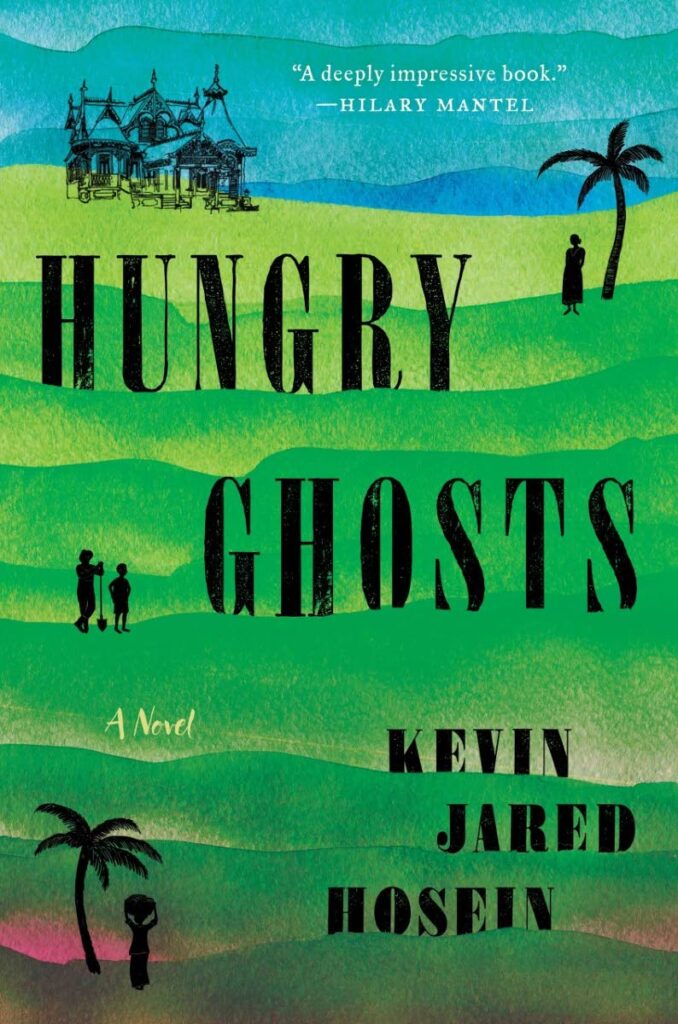Longing for life of Hosein's Hungry Ghosts

Kevin Jared Hosein’s latest novel, Hungry Ghosts, largely takes place in what seems a perversely unpromising, uneventful setting.
“This particular barrack” – one of many in the area – “sat by its lonesome, raw and jagged as a yanked tooth in the paragrass-spangled stretch of meadow, beyond the canefield, beyond the rice paddies, the village proper and the sugar mill – in a corner where God had to squint to see. Neighbour to nothing.”
It’s a desolate yet intriguing description that embodies the novel’s curious power. Hosein describes the mundane barrack rooms of Hungry Ghosts, somewhere in central Trinidad, as a place of “lesser lives”; and yet, as he rapidly makes clear, no one’s life is “lesser” to himself.
That adds to the intensity, universal appeal and epic scale that have already won international acclaim for this newly published book.
Undoubtedly life is cheap in Hosein’s world, snuffed out in an instant by casual violence or by illness that nowadays (the book is set in the 1940s) would be minor. As a result, his characters live at high pitch, on the edge of survival. Children and pregnant women can be carried away by an insect bite or infections picked up from dirty floodwater; a splinter can lead to gangrene; teenage boys contemplate murder.
They have already given the novel an ominous opening. “Four boys ventured to the river,” it begins, ordinarily enough – but the sentence ends, startlingly: “to perform a blood oath.” When the boys carry out their ritual, a few lines later, “The blood bubbled to the surface like their veins were boiling.” They might well be: in this book all the characters’ burning emotions run close to the surface, barely kept in check – if at all. When shortly afterwards the reader is warned of “the promise of coming darkness,” it simply underlines a fact that is already becoming plain, though the nature and extent of that “darkness” is shocking.
Hosein nimbly juggles an extensive, diverse cast. Sometimes a chapter relates the backstory of a character, revealing why he or she is constantly raging, full of malice, or at best careless of others. Elsewhere the reader more rapidly gets to know all the residents of the barracks and some of the people of the nearby village, such as Rookmin, the barrack’s resident expert on and ardent believer in evil spirits, who nevertheless dares to have hope for her afflicted daughter, and has the grace to show kindness to others around her; the quiet Mr Robinson, whose cameo appearances lay bare his good heart; Lata, a thoughtful, spirited girl, who believes – perhaps with too great an ambition – she can avoid the misery endured by her mother and the other women of the barrack rooms.

Hosein traces too the changes in personalities wrought by unfolding events. Hansraj Saroop initially has more self-restraint than his adolescent son, but their roles are almost reversed towards the end, though Krishna longs for his father to father him once more. But Hans has been twisted out of shape by a consuming passion.
The mysterious twins, Rudra and Rustam, are more opaque. No longer part of the community, they still know almost everything that happens there. They are sometimes victims, sometimes avengers; they can be cruel, but are not always evil. They seem at times to be presiding spirits, dispensing rough justice; agents of older forces than the deities to whom the Christian villagers and Hindu barrack-dwellers appeal, they embody the implacable Fates.
Religion plays an unfortunate role in the story; for instance, the Christian villagers look down on the Hindu barrack-dwellers, and though there are decent people of both faiths, one character’s conversion has a dire outcome.
Other elements too of the background to this saga – the end of indentureship, the arrival of the American forces and the influx of US dollars – are not entirely uncharted territory. The book’s antecedents include, for instance, Samuel Selvon’s (far more optimistic) A Brighter Sun; its wretchedly poor rural characters, vainly, endlessly battling a heartless world, recall those of Harold Sonny Ladoo’s No Pain like This Body. Another is Naipaul’s A House for Mr Biswas, which likewise conjures a whole community forced into an oppressive closeness more physical than emotional.
And the desire for a house is where some of the many troubles in Hungry Ghosts begins.
Hans and his wife Shweta want to buy a lot of land in the village of Bell. This is the theme of so much Caribbean literature, the longing for a house symbolising the psychological search for a home, the yearning to belong, and for betterment.
It's debatable whether Hans or Mr Biswas is more unlucky. But Mr Biswas gets, if nothing else, the house of Naipaul’s title, and dies feeling fortunate not “to have lived and died as one had been born, unnecessary and unaccommodated.”
Hans, by contrast, is described early on as a “blessed man,” and in some ways he is, though not materially. But like the protagonist of a classical Greek tragedy, he has a fatal flaw, first exposed by his simple, innocent dream of a house, which ends in his finding himself “dismantled and discarded by all the lives he wanted to live.”
There are ill omens early in each book: in Biswas, a drowned calf, in Hungry Ghosts, a dead dog – or, rather, dogs. Many dogs. But Mr Biswas’s failures, though disappointing and unsurprising, don’t have the grim inexorability of Hans’s; the latter’s desire to move out of the barrack room leads to a string of unthinkable disasters, as if even to hope for a better life were hubris. Or should all Hosein’s characters literally know their place, doomed to generations of poverty and trauma?
Hungry Ghosts is a dense, demanding read, though Hosein’s love of words is one of the book’s pleasures. His characters of course speak Trinidadian Creole, though the narrative voice is in the king’s English, at times not just coruscating, but positively baroque. A tarpaulin blown by the wind is flabellate. The big house has simple fenestration, through which its lights at night resemble the noctilucae of a river. Its mistress is arcuate.
It’s this linguistic exuberance, perhaps, that leads to one or two anachronisms, or words out of place: there were no buffalypso in the 1940s; and would a Trinidadian woman who had spent her teens in a 1940s Port of Spain brothel think of the city’s “bistros,” or of “coffee klatches”? Did rural Trinidadians of that time really drink in “pubs”? The big old house that is the centre and cause of much of the drama is: “A hodgepodge of things foreign and colonial and postcolonial and antebellum.” A hodgepodge indeed.
But events gallop on at a breakneck pace in this book packed with heartwrenching stories, and it’s precisely Hosein’s relish of the language that makes some of them bearable to read.
Much of the action of the book is brutal and squalid, yet is set against an often incongruously beautiful, equally carefully observed landscape: Hosein details the flowers and wild creatures, not all of them hostile; the humanity that most of his characters retain in the face of torments inflicted by life, often through their fellow men. As with other elements of the book, Hosein manages them masterfully. There are moments of humour, and some of the book’s best scenes are tragicomic.
But there are many hungry ghosts in this book; few are benign, and not all of them are dead. Some choose hate or fear, or themselves over others, and their choices have terrible consequences.
But some are resigned to their lot; some find consolation in their faith. Some rise above the temptation to strike back in bitterness. And for some, at the last, there is a faint chance of redemption, of freeing themselves from the iron grasp of pitiless destiny.
Thus Hosein leaves the reader, thankfully, not entirely without hope for the beleaguered inhabitants of his lonesome barrack beyond the canefield. The place may be a neighbour to nothing, but its people become the reader’s neighbours, and their lives and deaths and the suffering between are touching and horrifying human stories that keep their grip until the bittersweet end.


Comments
"Longing for life of Hosein’s Hungry Ghosts"